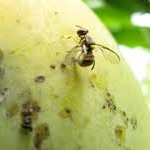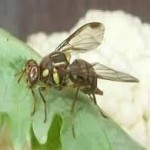Scabby Lesion or “kurikong” as it is known locally, is a serious problem among mango growers in the Philippines. Affected fruits have black scablike lesions on its skin.
“Kurikong” attacks the small fruits causing them to fall prematurely that it has become a perennial problem in the decrease of mango production in the country.
It has been diagnosed by the Bureau of Plant Industry’s National Mango Research and Development Center, that the damage is possibly caused by two insects.
Fruits having dry scabby lesions are infested by Capsid bug or Mirid bug (Helopiltis sp.) while fruits manifesting water soaked lesions with small, yellowish larvae are damaged by Cecid fly (Procontarinia sp.).
According to Dr. Hernani G. Golez, an entomologist and chief of the government run center, that both infestations are piercing sucking insects and feed on mango fruits , especially the young ones, leaving black marks and corky spots on the skin.
Adult insects prefer to stay in cool shady places and become active as the sunlight intensity decreases. Coffee, cacao, cotton, cashew and guava serve as alternative hosts of Capsid bugs while mango trees are the only host for Cecid flies.
The latter infest young leaves, producing round galls. When dissected, a gall contains small yellowish larvae (maggots). Mango growers can minimize damage from these insects by cultural approach and environmentally friendly pesticide management.
These practices include fruit bagging or wrapping, pruning, sanitation, proper insecticide application and trapping.
Dr. Oscar S. Opina, professor at the Department of Plant Pathology, University of the Philippines at Los Baños (UPLB) in Laguna, bagging is one practical control solution that can be adopted by mango growers.
Bagging or wrapping can be done as early as 40 days but not later than 60 days after flower induction. Pruning and sanitation are musts to prevent insects infestations. Prune trees after harvest. Remove overcrowded and dead branches for better air circulation and sunlight penetration.
Prune infested leaves and burn them. Sanitation practices include cleaning of surroundings, removing weeds and under brushing of shrubs and small trees.
Proper pesticide management to protect young leaves will minimize the problem. Choose environmentally friendly insecticide that is sprayed in either early in the morning or late in the afternoon to hit the feeding insects.
The use of yellow sticky traps will attract and eventually kill Cecid flies. This is done with the use of metal sheets painted with bright yellow color. The painted metal sheet is coated with used oil and hung on trees.
Light trapping can also be done to capture adult insects by placing a basin of water underneath the light to capture the insects attracted to it.

